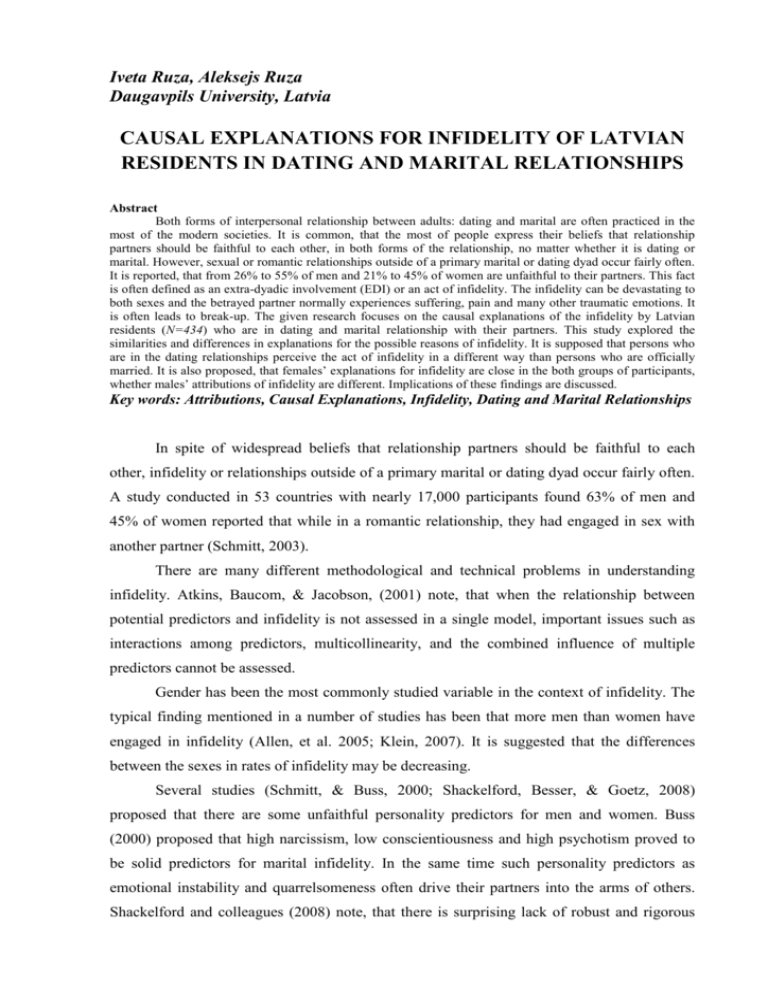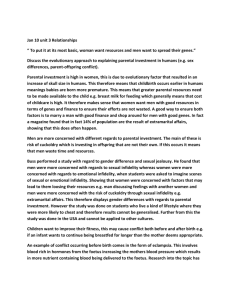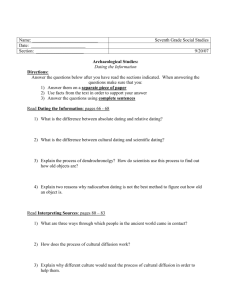
Iveta Ruza, Aleksejs Ruza
Daugavpils University, Latvia
CAUSAL EXPLANATIONS FOR INFIDELITY OF LATVIAN
RESIDENTS IN DATING AND MARITAL RELATIONSHIPS
Abstract
Both forms of interpersonal relationship between adults: dating and marital are often practiced in the
most of the modern societies. It is common, that the most of people express their beliefs that relationship
partners should be faithful to each other, in both forms of the relationship, no matter whether it is dating or
marital. However, sexual or romantic relationships outside of a primary marital or dating dyad occur fairly often.
It is reported, that from 26% to 55% of men and 21% to 45% of women are unfaithful to their partners. This fact
is often defined as an extra-dyadic involvement (EDI) or an act of infidelity. The infidelity can be devastating to
both sexes and the betrayed partner normally experiences suffering, pain and many other traumatic emotions. It
is often leads to break-up. The given research focuses on the causal explanations of the infidelity by Latvian
residents (N=434) who are in dating and marital relationship with their partners. This study explored the
similarities and differences in explanations for the possible reasons of infidelity. It is supposed that persons who
are in the dating relationships perceive the act of infidelity in a different way than persons who are officially
married. It is also proposed, that females’ explanations for infidelity are close in the both groups of participants,
whether males’ attributions of infidelity are different. Implications of these findings are discussed.
Key words: Attributions, Causal Explanations, Infidelity, Dating and Marital Relationships
In spite of widespread beliefs that relationship partners should be faithful to each
other, infidelity or relationships outside of a primary marital or dating dyad occur fairly often.
A study conducted in 53 countries with nearly 17,000 participants found 63% of men and
45% of women reported that while in a romantic relationship, they had engaged in sex with
another partner (Schmitt, 2003).
There are many different methodological and technical problems in understanding
infidelity. Atkins, Baucom, & Jacobson, (2001) note, that when the relationship between
potential predictors and infidelity is not assessed in a single model, important issues such as
interactions among predictors, multicollinearity, and the combined influence of multiple
predictors cannot be assessed.
Gender has been the most commonly studied variable in the context of infidelity. The
typical finding mentioned in a number of studies has been that more men than women have
engaged in infidelity (Allen, et al. 2005; Klein, 2007). It is suggested that the differences
between the sexes in rates of infidelity may be decreasing.
Several studies (Schmitt, & Buss, 2000; Shackelford, Besser, & Goetz, 2008)
proposed that there are some unfaithful personality predictors for men and women. Buss
(2000) proposed that high narcissism, low conscientiousness and high psychotism proved to
be solid predictors for marital infidelity. In the same time such personality predictors as
emotional instability and quarrelsomeness often drive their partners into the arms of others.
Shackelford and colleagues (2008) note, that there is surprising lack of robust and rigorous
research on this topic. However, there was a proposed support for a causal model according to
which people with particularly disagreeable spouses (i.e., those low on Agreeableness) and
particularly unreliable spouses (i.e., those low on Conscientiousness) are less satisfied with
their marriage, leading them to estimate a higher probability of becoming extramaritally
involved in the next year. Low conscientiousness and low agreeableness share the common
component of impulsivity and inability to delay gratification and are robust predictors of
infidelities. These findings suggest that a personality style marked by impulsivity, low
dependability, and low reliability in general carries over into the sexual sphere.
There are five categories of motives for infidelity distinguished by Drigotas, Safstrom,
& Gentilia, (1999). They are as follows: sexuality, emotional satisfaction, social context,
attitudes-norms, and revenge-hostility. Sexuality motives include the desire for variety and
dissatisfaction with the primary sexual relationship. Emotional satisfaction might imply
relationship dissatisfaction, ego bolstering, and/or emotional attachment to the other person.
Social contextual factors refer to opportunity and absence of the primary partner. Attitudesnorms include sexually permissive attitudes and norms. Revenge-hostility applies to infidelity
that occurs in retaliation for some perceived wrong by the partner.
The number of studies determines links between people’s responses towards their own
or partner’s infidelity and causal explanations, revealing how such extra-dyadic relations are
perceived and explained (Mongeau, Halle, & Alles, 1994; Hall, & Fincham, 2006).
DeGenova and Rice (2005) highlighted several experimental functions of dating
relationships for youth, such as exploring gender roles, aspects of self-identity, and sexuality,
noted the lack of clear "rules" for dating in contemporary culture, and described the divergent
priorities college students have for dating versus marriage. While getting married typically
involves a significant commitment to the relationship from both partners (Kline et al., 2004),
dating relationships often have lower levels of commitment (Edin, Kefalas, & Reed, 2004),
and dating men may even deceive partners about their levels of commitment to the
relationship (Tooke & Camire, 1991).
On the other hand, Roscoe, Cavanaugh, and Kennedy (1988) noted similarities in
behaviors seen in dating and marital relationships and stated that "in many respects dating is
preparation for marriage, and may lead to the establishment of behavioral patterns which will
be maintained in marriage" (p. 37). Sexually permissive attitudes and attachment styles that
involve anxiety over abandonment may predict likelihood of engaging in dating infidelity
McAnulty & Brineman (2007).
The objective of the given study is to figure out if there are any differences on causal
explanations for infidelity between persons in different type of the relationship (dating or
marital). Two major aspects of the researched problem have been considered in this study: (a)
causal attributions towards women’s infidelity, and (b) causal attributions of infidelity men’s
infidelity. Taking into account the possible gender differences in perception of and
explanations for infidelity, the causal explanations for infidelity of the male and female
participants were compared separately from each other.
METHOD
Participants
The sample consisted of 434 Latvian residents (148 males, 34.91%; 286 females, 65.9%). The
mean age was 29.90 (SD = 9.80) ranging from 18 to 56. The participants were people of
different education and occupation living in Latvian cities and countryside. The sample
consisted of 278 (64.1%) married residents and 156 (35.9%) residents reported to be in dating
relationship.
Procedure
All participants were asked to fill out the Infidelity Questionnaire (INFQ) consisted of 24
items, which they had to asses with 5-point scale to indicate the importance of a given cause
(1 = not important at all, 5 = very important).
Instrumentation
The modified Infidelity Questionnaire (INFQ) developed by Yeniçeri & Kökdemir (2006)
was used in this study. It was adapted for Latvian and Russian sample. The modification of
this questionnaire allowed combining INFQ-W and INFQ-M forms into one form used by
both sexes in order to get responses concerning as to attributions of infidelity towards
respondents’ gender group (i.e. in-group attributions) as well as attributions towards the
partner’s gender group (i.e. out-group attributions). The questionnaire consists of six
components: (a) legitimacy, which implies the effect of “revenge”. This component seems to
state that the partner in the relationship deserves to be cheated; (b) seduction, which implies
the effect of a “third person”; (c) normalization, which underlines concept that infidelity is a
normal act; (d) sexuality, referring to the quality of the sexual relationship between a person
and his or her partner; (e) social background, describing the cultural peculiarities and
circumstances in which the relationship with partner was established; and (f) sensation
seeking, corresponding to person’s activity in seeking for sensual experience.
Design
This study used a 2 (sex of participant: male, female) × 2 (type of the relationship) × 2 (ingroup attributions and out-group attributions) independent groups factorial design.
RESULTS
Because of the significant gender differences confirmed in the previous studies (Ruza
& Ruza, 2011), two separate comparisons along (INFQ) components were made in the given
study. The first comparison involved the female participants who reported themselves to be in
marital or dating relationship.
Independent Sample t-test was used in order to confirm the difference. The mean (M)
and Standard Deviation (SD) values of each INFQ component relevant to each group of
participants are presented in the Table 1.
1. Table Differences in causal attributions towards women’s and men’s infidelity of married
females and those, who are in dating relationship
Component
Legitimacy
Seduction
Normalization
Sexuality
Social Background
Sensation Seeking
Type of the
Women’s infidelity
Men’s infidelity
relationship
(M)
(SD)
t-test
(M)
(SD)
t-test
Married
14,97
3,826
-1.570
15,74
3,394
-.200
Dating
15,67
3,562
15,82
3,511
Married
10,03
3,642
13,99
3,753
Dating
10,21
3,331
13,66
3,081
Married
9,35
3,413
11,49
3,626
Dating
9,33
3,172
10,80
3,556
Married
13,10
3,631
15,92
2,960
Dating
13,58
3,002
16,07
2,715
Married
11,09
3,631
12,45
3,961
Dating
12,36
3,243
13,53
3,174
Married
12,13
3,837
14,95
3,310
Dating
12,41
3,409
14,52
3,420
-.431
.063
-1.161
-3.029**
-.617
.780
1.596
-.438
-2,561**
1.043
** p>.01
The results showed the only one significant difference (p>.01) between groups in
‘Social Background’ component. In both cases explaining as women’s as well as men’s
infidelity reasons, the ‘Social Background’ component was reported to be much more
reasonable cause for infidelity for female participants who reported themselves to be in dating
relationship than those who are married.
The second comparison involved the male participants who reported themselves to be
in marital or dating relationship. The mean (M) and Standard Deviation (SD) values of each
INFQ component relevant to each group of participants are presented in the Table 2.
Table 2. Differences in causal attributions towards women’s and men’s infidelity of married
males and those, who are in dating relationship
Component
Legitimacy
Seduction
Normalization
Sexuality
Social Background
Sensation Seeking
Type of the
Women’s infidelity
Men’s infidelity
relationship
(M)
(SD)
t-test
(M)
(SD)
t-test
Married
14,07
3,969
-.901
14,99
3,761
-.014
Dating
14,70
3,609
15,00
3,416
Married
13,02
3,713
13,89
4,252
Dating
12,88
4,031
14,49
3,725
Married
11,71
3,668
10,65
4,243
Dating
12,09
3,829
11,79
3,967
Married
13,26
3,320
14,61
3,381
Dating
13,53
2,898
15,79
3,098
Married
11,49
3,519
11,91
3,910
Dating
12,63
3,471
13,53
3,535
Married
13,30
3,498
14,12
3,666
Dating
13,26
3,619
14,23
3,585
.196
-.563
-.479
-1.800
-.77
-.810
-1.516
-1.976*
-2,050**
-.165
* p>.05
** p>.01
The results indicated no significant differences in any INFQ component between
groups of participants in causal explanations for women’s infidelity. However, there were
determined the significant differences between groups in ‘Sexuality’ component (p>.05) and
in ‘Social Background’ component (p>.01) in causal explanations for men’s infidelity. In
both cases the ‘Sexuality’ and ‘Social Background’ components were reported to be much
more reasonable causes for infidelity for those male participants who reported to be in dating
relationship than those who reported to be married.
DISCUSSION
This study aimed to represent how persons involved in the different type of the
relationship perceive and explain the possible reasons for women’s and men’s infidelity. The
general people’s belief that relationship partners should be faithful to each other, in both
forms of the relationship, no matter whether it is dating or marital could be also a possible
explanation why males and females involved in the different types of the relationship tend to
provide very close explanations for infidelity reasons. The only exception emerged in both
samples was ‘Social Background’ component, which consisted of such indicators as
“marrying young”, “having an arranged marriage”, “growing up in a conservative culture”,
and “having few romantic relationships during adolescence”, which seemed to be much more
reasonable causes for infidelity for those participants who reported to be in dating
relationship. The results are partly consistent with Yeneceri & Kokdemir (2006) original
study proposed that if this freedom is restricted for any reason such as social background,
culture, or physical environment, men are expected to be unfaithful when they are able to
have a romantic relationship.
The current study is limited in several ways that suggest directions for future work.
One limitation pertains to the sample, which was chosen from a single culture and a relatively
restricted age range. Though the age of the participants was ranging from 18 to 56, the most
of participants were undergraduate and postgraduate students of Latvian Colleges and
Universities, so the number of persons who are older than 30 was not enough in order to
represent the real population of Latvia. It is possible that the current studies missed some
important reasons of infidelity that might be more likely to occur in older persons, who might
be more experienced in the domains of perceiving and committing infidelity.
Another limitation of this research is a methodological one. Participants were
instructed to fill out 24 items of INFQ, which were classified into six components. However,
analyzing the verbal responses of the most of participants, following this study, there emerged
many other possible reasons of infidelity, out of INFQ items.
Therefore, an important direction for future work could be developing an instrument
measuring causal explanations for infidelity taking into account the specific features and
peculiarities more relevant to the modern Latvian Society.
Bibliography
1. Atkins, D.C., Baucom, D.H., Jacobson, N. S. (2001). Understanding infidelity:
Correlates in a national random sample. Journal of Family Psychology. Vol 15(4),
Dec 2001, 735-749.
2. Allen, E., Atkins, D., Baucom, D., Snyder, D., Coup Gordan, K., & Glass, S. (2005).
Intrapersonal, interpersonal, and contextual factors in engaging in and responding to
extramarital involvement. Clinical Psychology: Science and Practice, 12 (2),101-130.
3. DeGenova, M. K., & Rice, F. P. (2005). Intimate relationships, marriages, and families
(6th ed.). Boston, MA: McGraw Hill Higher Education
4. Drigotas, S. M., Safstrom, A., & Gentilia, T. (1999). An investment model prediction
of dating infidelity. Journal of Personality and Social Psychology, 77, 509-524.
5. Edin, K., Kefalas, M. J., & Reed, J. M. (2004). A peek inside the black box: What
marriage means for poor unmarried parents. Journal of Marriage and Family, 66,
1,007-1,014,
6. Hall, J. H., & Fincham, F. D. (2006). Relationship dissolution following infidelity:
The roles of attributions and forgiveness. Journal of Social and Clinical Psychology,
25, 508-522.
7. Kleine, M. (2007). For Better or for Worse? The impact of accounts and attributions
following sexual infidelity. PhD dissertation, University of Missouri – Columbia.
http://edt.missouri.edu/Fall2007/Dissertation/KleineD-030509-D8569/research.pdf
8. Kline, G. H., Stanley, S. M., Markman, H. J., Olmos-Gallo, P. A., St. Peters, M.,
Whitton, S. M., et al. (2004). Timing is everything: Pre-engagement cohabitation and
increased risk for poor marital outcomes. Journal of Family Psychology, 18, 311-318.
9. McAnulty, R., & Brineman, J. M. (2007). Infidelity in dating relationships. Annual
Review of Sex Research, 17, 94-114.
10. Mongeau, P. A., Halle, J. L., & Alles M. (1994). An Experimental Investigation of
Accounts and Attributions Following Sexual Infidelity. Communication Monographs,
vol. 61 No.4 p. 326-44 Dec 1994.
11. Roscoe, B., Cavanaugh, L. E., & Kennedy, C. A. (1988). Dating infidelity: Behaviors,
reasons, and consequences. Adolescence, 23, 35-43.
12. Ruža, I., & Ruža, A. (2010) Causal Attributions of Infidelity of Latvian Residents with
Different Kinds of Infidelity Experience. International Journal of Interdisciplinary
Social Sciences, Volume 5, Issue 2, pp.535-548
13. Shackelford, T. K., Besser, A., & Goetz, A. T. (2008). Personality, marital
satisfaction, and probability of marital infidelity. Individual Differences Research, 6,
13-25.
14. Schmitt, D. P., & Buss, D. M. (2000). Sexual dimensions of personal description:
Beyond or subsumed by the big five? Journal of Research in Personality, 34, 141-177.
15. Schmitt, D. (2003). Universal sex differences in the desire for sexual variety: Tests
from 52 nations, 6 continents and 13 islands. Journal of Personality and Social
Psychology, 85, 85–104.
16. Tooke, W., & Camire, L. (1991). Patterns of deception in intersexual and intrasexual
mating strategies. and Sociobiology, 12, 345-364.
17. Yeneceri, Z., & Kokdemir, D. (2006). University students’ perceptions of, and
explanations for, infidelity: The development of the infidelity questionnaire (INFQ).
Social Behavior and Personality: An International Journal, 34(6), 639-650.








